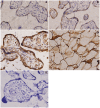Expression of osteoprotegerin in placenta and its association with preeclampsia
- PMID: 22952959
- PMCID: PMC3431377
- DOI: 10.1371/journal.pone.0044340
Expression of osteoprotegerin in placenta and its association with preeclampsia
Abstract
Background: Osteoprotegerin (OPG), a key regulatory factor in bone metabolism, was documented also a potential pro-angiogenic factor, which acts an important role in protecting vascular endothelial cells. Since preeclampsia has gradually been employed to be vascular diseases, we speculated that OPG might be associated with preeclampsia. The study was to evaluate the level of OPG protein and mRNA in placenta, and investigate the relationship between OPG and the pathogenesis of preeclampsia.
Methodology/principal findings: Placental specimens from 30 term normal pregnancy, 30 severe preeclampsia and 30 mild cases were studied. The expression and levels of OPGs' protein and mRNA were detected by immunohistochemistry, western blot analysis and real-time quantitative PCR analysis respectively. The expression of OPG protein was found in cytoplasm of placenta cytotrophoblasts and syncytiotrophoblasts in three groups. There were no significant differences of OPG protein between the maternal and fetal side in each group. The OPG protein and mRNA levels in severe preeclampsia were significantly higher than those in mild cases and normal pregnancy. However, there were no markedly differences of the OPG protein and mRNA levels between term delivery and preterm delivery in severe cases. In preeclampsia, the OPG protein and mRNA level was positively correlated with systolic blood pressure and 24 h urinary protein respectively.
Conclusions/significance: OPG protein and mRNA level in placentas of preeclampsia were found abnormal compared with normal pregnancy. In preeclampsia, the OPG protein and mRNA levels were closely related with its important clinical parameters. Taken together, OPG might be closely correlated with the pathogenesis of preeclampsia.
Conflict of interest statement
Figures




Similar articles
-
[Study of adiponectin expression in placenta and its correlation with preeclampsia].Zhonghua Fu Chan Ke Za Zhi. 2008 Feb;43(2):90-3. Zhonghua Fu Chan Ke Za Zhi. 2008. PMID: 18683744 Chinese.
-
[Expression changes of the growth arrest and DNA damage 45 alpha gene in placenta in patients with preeclampsia and its clinical significance].Zhonghua Fu Chan Ke Za Zhi. 2010 Nov;45(11):833-7. Zhonghua Fu Chan Ke Za Zhi. 2010. PMID: 21211282 Chinese.
-
[Expression of hypoxia-inducible factor-1alpha, vascular endothelial growth factor and sFlt-1 in preeclampsia placenta].Zhonghua Fu Chan Ke Za Zhi. 2006 Jul;41(7):440-4. Zhonghua Fu Chan Ke Za Zhi. 2006. PMID: 17083805 Chinese.
-
Reduced expression of survivin, the inhibitor of apoptosis protein correlates with severity of preeclampsia.Placenta. 2012 Jan;33(1):47-51. doi: 10.1016/j.placenta.2011.10.008. Epub 2011 Oct 26. Placenta. 2012. PMID: 22033156
-
Expression of RhoA in placenta of preeclampsia.J Huazhong Univ Sci Technolog Med Sci. 2006;26(6):744-6. doi: 10.1007/s11596-006-0633-1. J Huazhong Univ Sci Technolog Med Sci. 2006. PMID: 17357507
Cited by
-
Placenta-Derived Osteoprotegerin Is Required for Glucose Homeostasis in Gestational Diabetes Mellitus.Front Cell Dev Biol. 2020 Sep 1;8:563509. doi: 10.3389/fcell.2020.563509. eCollection 2020. Front Cell Dev Biol. 2020. PMID: 32984349 Free PMC article.
-
Comparative proteome profile of human placenta from normal and preeclamptic pregnancies.PLoS One. 2013 Oct 18;8(10):e78025. doi: 10.1371/journal.pone.0078025. eCollection 2013. PLoS One. 2013. PMID: 24205073 Free PMC article.
-
Placental Transcriptome Adaptations to Maternal Nutrient Restriction in Sheep.Int J Mol Sci. 2021 Jul 17;22(14):7654. doi: 10.3390/ijms22147654. Int J Mol Sci. 2021. PMID: 34299281 Free PMC article.
-
Inconformity of CXCL3 plasma level and placenta expression in preeclampsia and its effect on trophoblast viability and invasion.PLoS One. 2014 Dec 8;9(12):e114408. doi: 10.1371/journal.pone.0114408. eCollection 2014. PLoS One. 2014. PMID: 25485631 Free PMC article.
-
Soluble receptors for advanced glycation end products and receptor activator of NF-κB ligand serum levels as markers of premature labor.BMC Pregnancy Childbirth. 2015 Jun 10;15:134. doi: 10.1186/s12884-015-0559-3. BMC Pregnancy Childbirth. 2015. PMID: 26059227 Free PMC article.
References
-
- Yücesoy G, Ozkan S, Bodur H, Bodur H, Tan T, et al. (2005) Maternal and perinatal outcome in pregnancies complicated with hypertensive disorder of pregnancy: a seven year experience of a tertiary care center. Arch Gynecol Obstet 273(1): 43–49. - PubMed
-
- Wolf M, Sandler L, Munoz K, Hsu K, Ecker JL, et al. (2002) First trimester insulin resistance and subsequent preeclampsia: a prospective study. J Clin Endocrinol Metab 87(4): 1563–1568. - PubMed
-
- Brodszki J, Länne T, Laurini R, Strevens H, Wide- Swensson D, et al. (2008) Vascular mechanical properties and endothelial function in pre-eclampsia with special reference to bilateral uterine artery notch. Acta Obstet Gynecol Scand 87(2): 154–162. - PubMed
Publication types
MeSH terms
Substances
LinkOut - more resources
Full Text Sources

